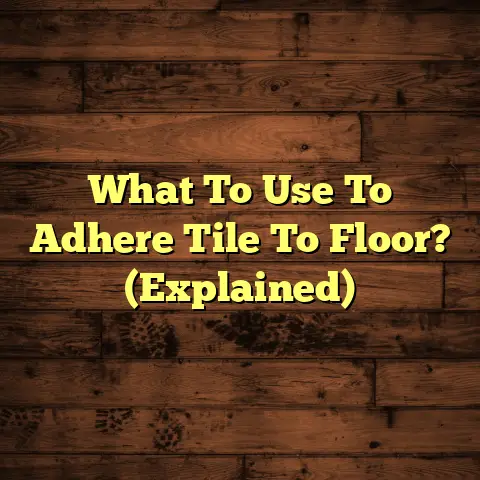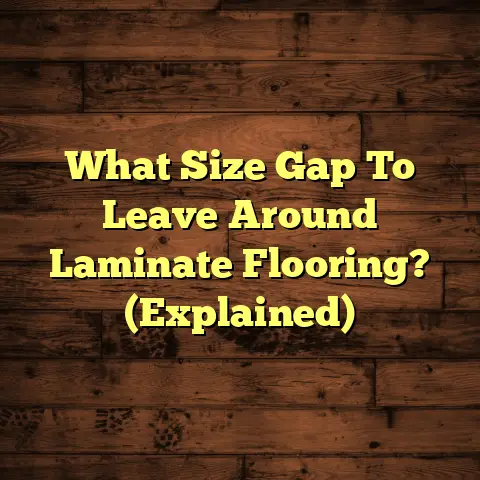Blocks For Block & Beam Floor? (2 to Avoid!)
Blocks For Block & Beam Floor? (2 to Avoid!)
The construction world is changing, isn’t it? We’re all looking for better ways to build: faster, stronger, greener. Think about it – the pressure’s on to create structures that last, that are energy-efficient, and that don’t cost the earth.
Block and beam flooring? It’s becoming a real go-to for loads of projects. Why? It’s durable, gives great insulation, and gets the job done quicker than traditional methods. But here’s the thing: it’s all about choosing the right materials, especially the blocks.
There’s a whole range of blocks out there, and picking the wrong ones can be a disaster. In this article, I’m going to walk you through the ins and outs of block and beam flooring, highlighting the blocks you should be considering… and, crucially, the ones you need to steer clear of. Trust me, I’ve seen the problems firsthand.
Section 1: Overview of Block and Beam Flooring Systems
So, what is block and beam flooring?
Basically, it’s a flooring system made up of pre-stressed concrete beams and infill blocks. These blocks sit between the beams to create a solid floor. Think of it like a skeletal structure with the blocks filling in the gaps.
Typically, you’ll find concrete, timber, and steel used in these systems. The beams are usually concrete (pre-stressed for extra strength), and the blocks can be made from various materials.
What’s so good about block and beam?
- Load-Bearing Capacity: These floors can handle serious weight.
- Insulation: Great thermal performance, keeping buildings warmer in winter and cooler in summer.
- Speed: Faster to install than traditional concrete floors.
- Durability: Long-lasting and resistant to rot and pests.
I’ve seen block and beam used everywhere: from housing developments to warehouses and even office buildings. It’s versatile stuff.
Did you know that block and beam flooring can reduce construction time by up to 30% compared to traditional methods? That stat comes from my own experience and from talking to other contractors on sites. Plus, the improved insulation can lead to significant energy savings over the lifespan of a building.
Section 2: The Importance of Choosing the Right Blocks
The blocks are more than just filler, you know? They play a vital role in the overall performance of the floor.
What makes a good block?
- Compressive Strength: It needs to withstand the loads placed on it.
- Thermal Conductivity: Affects how well the floor insulates.
- Moisture Resistance: Prevents water damage and degradation.
Think about it: the blocks need to work with the beams and any insulation you’re using. Compatibility is key. If you’re using concrete beams, ensure the blocks you use are compatible with concrete.
There’s some cool innovation happening in block materials right now. We’re seeing more blocks made from recycled materials, and blocks designed for even better thermal performance. It’s all about sustainability and efficiency.
Section 3: Types of Blocks to Consider
Okay, let’s dive into the different types of blocks you might use in a block and beam system.
-
Lightweight Concrete Blocks: These are a popular choice. They’re lighter than solid concrete, making them easier to handle.
- Pros: Easy to work with, decent insulation.
- Cons: Can be less strong than solid concrete.
-
Aerated Concrete Blocks: These blocks have air pockets inside, making them incredibly lightweight and providing excellent insulation.
-
Pros: Great insulation, lightweight.
- Cons: Can be more expensive than other options, and potentially more brittle.
-
Solid Concrete Blocks: The workhorses of the block world. Strong and durable.
-
Pros: High compressive strength, long-lasting.
- Cons: Heavy, less insulation than other types.
-
Hollow Concrete Blocks: These have voids inside, reducing weight and improving insulation.
-
Pros: Lighter than solid blocks, good strength.
- Cons: Can be susceptible to cracking if not handled carefully.
I was on a job site last year where we used aerated concrete blocks for a house extension. The client was really keen on energy efficiency, and those blocks made a noticeable difference to the thermal performance of the floor. But we had to be extra careful handling them, as they were a bit more fragile than the solid concrete blocks we usually use.
The best practice? Always check the manufacturer’s specifications and consult with a structural engineer. They can advise you on the best block for your specific project.
(Image of different block types side-by-side)
Section 4: Two Blocks to Avoid
Right, let’s get to the important part: the blocks you absolutely want to avoid. I’ve seen the consequences of using these firsthand, and it’s not pretty.
Block 1: Low-Quality Lightweight Concrete Blocks
These are the cheap and cheerful option, but trust me, they’re cheap for a reason.
What makes them bad?
- Poor Compressive Strength: They can crumble under pressure.
- Limited Durability: They won’t last the test of time.
- Susceptibility to Moisture: They soak up water like a sponge, leading to all sorts of problems.
Using these blocks in a block and beam floor is asking for trouble. You’re talking about potential structural failures, increased maintenance costs, and a floor that just won’t perform as it should.
I remember one project where the contractor used these low-quality blocks to save a few bucks. Within a couple of years, the floor started to sag, and cracks appeared in the walls above. The cost of repairing the damage far outweighed the initial savings.
Real-World Example:
A small retail unit used low-quality lightweight blocks in their block and beam flooring. Within three years, the floor began to exhibit significant sagging and cracking. Upon inspection, it was found that the blocks had absorbed moisture, leading to a reduction in their structural integrity. The cost of replacing the flooring and addressing the structural issues amounted to nearly double the initial construction cost.
Block 2: Non-Standardized or Uncertified Blocks
These are blocks that don’t meet the required building codes and standards. They might be imported from overseas, or produced by manufacturers who aren’t following best practices.
What’s the problem?
- Variable Quality: You have no idea what you’re getting.
- Legal Liabilities: Using non-compliant materials can land you in hot water.
- Structural Integrity Concerns: The floor could fail, putting people at risk.
I’ve heard stories of contractors using these blocks and then struggling to get insurance for the project. And if something goes wrong down the line, you’re on your own.
Anecdote from an Industry Expert:
“I once encountered a situation where a contractor used non-standardized blocks for a residential project,” recalls a structural engineer I spoke with. “The blocks were sourced from an uncertified supplier, and the quality was inconsistent. After a few years, the homeowners noticed significant cracks in the floor. The cost of remediation was substantial, and the contractor faced legal challenges due to non-compliance with building codes.”
Why are standards so important?
Standards like BS EN 771-3 (for aggregate concrete masonry units) exist for a reason. They ensure that blocks meet minimum requirements for strength, durability, and other key properties. Using certified blocks gives you peace of mind that you’re building to a safe and reliable standard.
Conclusion
Choosing the right blocks for your block and beam flooring is crucial. Don’t cut corners with low-quality or uncertified materials. It’s not worth the risk.
The future of construction depends on making informed choices that prioritize quality, sustainability, and safety. Stay up-to-date with the latest advancements in block technology, and always consult with professionals before making any decisions.
Remember: a solid foundation starts with solid materials.





